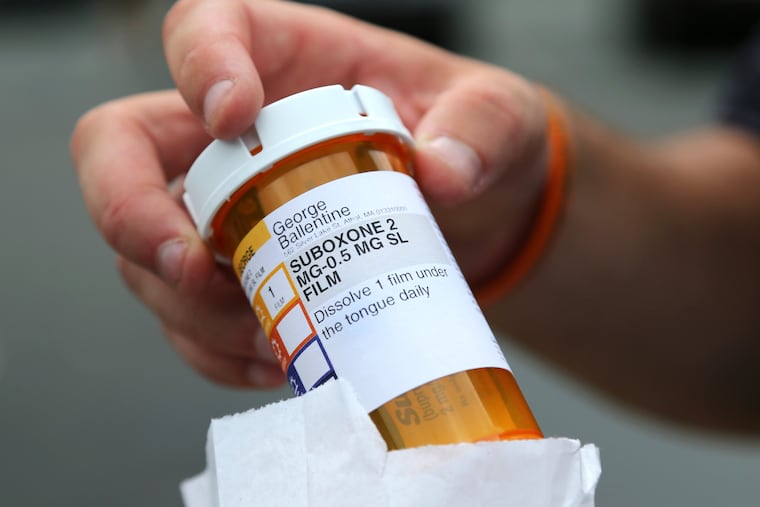Congress should back buprenorphine bill to stem opioid crisis | Opinion
U.S. lawmakers introduced a bill this month pushing to expand a life-saving treatment for opioid addiction. It's long overdue.

U.S. lawmakers introduced a bill earlier this month pushing to expand a lifesaving treatment for opioid addiction, buprenorphine. For almost 20 years, doctors like myself have been required to undergo special training and licensing to prescribe buprenorphine for people struggling with opioid addiction. Yet from our earliest days of training, we could prescribe medications such as oxycodone and fentanyl, two culprits at the heart of the opioid epidemic. In the midst of a national crisis, it is beyond overdue that policymakers remove this burdensome regulation and expand critical access to buprenorphine to treat opioid addiction.
Passed by Congress in 2000, this regulation originates from the Drug Addiction Treatment Act, which intended to expand treatment beyond specialized methadone treatment programs and into primary care clinics. However, the legislation also introduced new training and license requirements, known as the “X waiver,” that largely stymied these efforts. To prescribe buprenorphine, doctors must undergo eight hours of training (24 hours for nurse practitioners and physician assistants) and complete a waiver application. Then the waiver caps the number of patients who can be treated and subjects clinicians to extra documentation requirements and random office inspections.
Nineteen years later, we stand in the depths of a national opioid emergency. In 2017, over 70,000 Americans died of drug overdose, nearly 48,000 of which were from opioids. That surpassed the peak annual death tolls of the AIDS epidemic and gun violence in the last 50 years. The federal government estimated the economic cost of the epidemic to be $504 billion in 2015, nearly 3% of U.S. gross domestic product.
Pennsylvania is no exception, claiming the highest number of drug overdose deaths and third highest overdose death rate in the U.S.
Unfortunately, the epidemic is far from over. A recent study predicted that at the current trajectory, another 700,000 Americans will die from opioid overdose by 2025, a sum greater than the combined total U.S. combat deaths from every war since the American Revolution. Among the solutions needed to reverse the epidemic, expanding access to a medication that we know can save lives is critical.
Addiction treatment access, for buprenorphine especially, is poor. According to the surgeon general, only 12% of individuals with opioid addiction receive treatment. Owing largely to licensing hurdles to prescribe buprenorphine, only 7% of U.S. clinicians hold an X waiver. Geographically, 42% of all U.S. counties have no approved buprenorphine prescriber. Coverage is even worse in rural counties.
Buprenorphine is among the most effective medications to treat opioid addiction. Most importantly, it reduces risk of death for people addicted to opioids. France, facing increasing heroin use in the 1990s, deregulated buprenorphine, permitting doctors to prescribe it without extra training or licensing. The policy change reaped immediate benefits. Ten times more patients received addiction treatment, and within four years, opioid overdose deaths decreased by nearly 80%. Even if the U.S. could only partially replicate this success, we could save thousands of lives.
Critics have charged that expanding buprenorphine prescribing could lead to increased overdoses and diversions to someone beyond the original prescribe patient. However, buprenorphine has a better safety record than other regularly prescribed opioids. From 2002 to 2013, only 464 deaths involving buprenorphine were reported to the federal government. Research also suggests that when buprenorphine is diverted, it is most often used to self-treat addiction and withdrawal. Others argue it replaces one drug with another, a damaging mischaracterization. Analogous to treating chronic diseases like diabetes or hypertension, addiction is a chronic brain disorder requiring long-term treatment with medications like buprenorphine.
Deregulating buprenorphine alone will not fix the opioid epidemic. A comprehensive strategy should include expanding access to addiction medications and psychosocial supports; harm-reduction measures, including needle-exchange programs and naloxone distribution; safer alternatives for chronic pain; robust drug-monitoring programs; and reducing the stigma of addiction, which requires recognizing addiction as the chronic medical condition it is rather than a moral failing.
Our national opioid emergency demands nothing less than urgent action. My patients and millions of others do not have time to wait. Buprenorphine saves lives, and we must expand access to this lifesaving medication. It is time to “X the X waiver.”
Robert Bonacci, M.D., MPH received his M.D. from the University of Pennsylvania and is a resident physician in Global Health Equity and Internal Medicine at Brigham and Women’s Hospital in Boston. @RobertBonacci